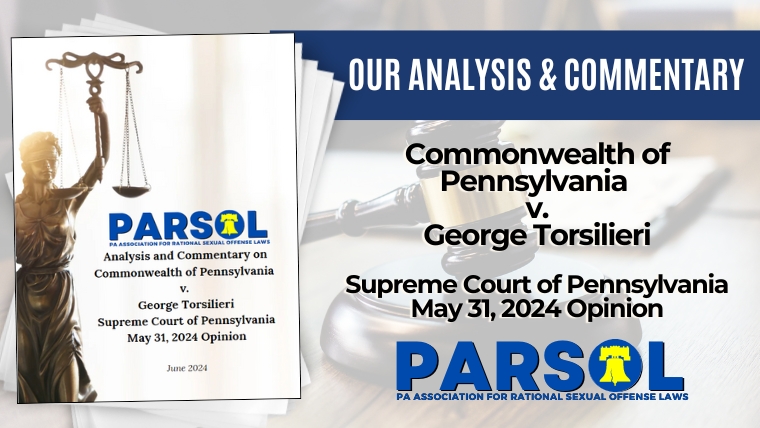WHAT? The neck’s an intimate part of the body? Since when? Since 9/29/22 by the Supreme Court of Pennsylvania in a 5 to 2 ruling on Commonwealth v. Carl Gamby, 62 MAP 2021. They considered “whether the unwanted kissing of a person’s neck constitutes the touching of ‘sexual or other intimate parts’ for purposes of the crime of indecent assault,” (Maj. Op. pg.1).
How did they reach this ridiculous conclusion? They determined “that ‘other intimate parts’ are those parts of the body that are personal and private, and which a person ordinarily allows to be touched only by other individuals with whom the person has a close personal relationship, and which are commonly associated with sexual relations or intimacy,” (Maj. Op. pg.1). The majority opinion was written by Justice Todd. Justices Donohue and Wecht filed separate dissenting opinions.
As the court further explained in the footnote on page one, “a conviction for indecent assault [18 Pa.C.S. § 3126] depends upon a finding of ‘indecent contact,’ 18 Pa.C.S. § 3101, which, as written, expresses two distinct concepts which must be proven. First, indecent contact requires the touching of ‘sexual or other intimate parts’ of the person, and, second, such touching must be for the purpose of arousing or gratifying sexual desire. 18 Pa.C.S. § 3101. This appeal focuses on the former requirement.”

Justice Donohue reasons, “[t]o support a conviction for indecent assault, the Commonwealth must establish that the actor (1) touched, for purposes of sexual gratification, (2) an intimate part of the body. This case does not implicate the first prong. Instead, it presents the straightforward question of whether the General Assembly intended, when defining the term ‘indecent contact,’ to include the neck as an ‘intimate part’ of the body. While undefined, I conclude that to be an ‘intimate part’ the body part must customarily be hidden from public view due to its personal and private nature. The neck does not qualify as such,” (Diss. Donohue pg.1).
I highly agree more with Justice Wecht’s position, “[t]he General Assembly has defined ‘indecent contact’ as any ‘touching of the sexual or other intimate parts of the person for the purpose of arousing or gratifying sexual desire, in any person.’ The General Assembly has left the phrase ‘other intimate parts’ undefined… In attempting to clarify the phrase, the Majority adds further confusion, stating that it refers to ‘those parts of the body that are personal and private, and which a person ordinarily allows to be touched only by other individuals with whom the person has a close personal relationship, and which are commonly associated with sexual relations or intimacy.’ Because the Majority’s virtually boundless definition of ‘other intimate parts’ muddles the criminal law more than clarifies it, I cannot endorse its use,” (Diss. Wecht pg.1).
Justice Wecht hits the nail on the head! He further goes on explaining how the term “intimate” carries many meanings. One person can understand “intimate” on a non-sexual level such as a very close friend while another person can take it to the sexual level. Let’s look at it from the viewpoint of body parts. Clearly anyone would consider the body’s genitalia an “intimate part” as they’re commonly used for sexual purposes. But what about the elbow, fingers, or even the nose for that matter which are usually uncovered? The Majority’s ruling creates a slippery slope where I can now be charged with indecent assault if I my hand grazes someone else’s hand because that person can say they’re hand is intimate to them.
Summing up the point, ‘[t]he variations between what might be considered ‘intimate’ would differ widely, and would be substantially affected by factors such as age, gender, social and religious beliefs, etc. A twenty-eight-year-old member of a kink community likely would disagree with an eighty-year-old member of an Amish community as to what falls within the definition of an ‘intimate’ part,” (Diss. Wecht pg.5). The term “obscene” another one that has challenged the legal and legislative realms. So much so that a multi-pronged test was developed to determine what was obscene. The third prong of the test is still troubling, whether the object lacks any serious literary, artistic, political or scientific value. It still boils down to a person’s individual viewpoint of art. What is obscene to one person isn’t always to another. I can view Michelangelo’s David as a piece of art while someone else who grew up in a strict manner could see it as obscene for its nudity factor. It just goes to show that trying to interpret a term for legal and legislative purposes isn’t always clear cut. It’s easy to interpret a term for oneself but much more difficult for a multi-cultural society. I wish the other five Justices would’ve seen it this way too.




